Last updated on June 28th, 2013
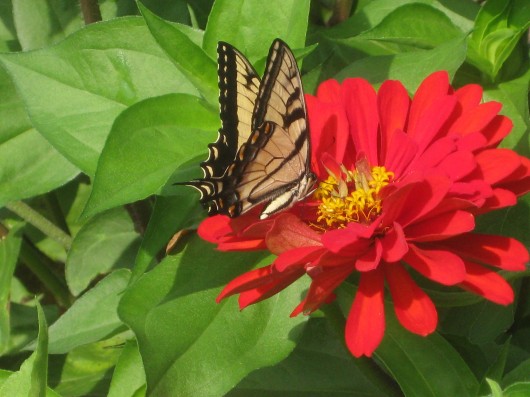 I USUALLY LET UP A LITTLE IN JULY, when soaring temperatures and oppressive humidity make most gardening jobs unbearable. The main focus now is weeding, watering, butterfly-watching (do you do this too?) and tending to vegetable crops:
I USUALLY LET UP A LITTLE IN JULY, when soaring temperatures and oppressive humidity make most gardening jobs unbearable. The main focus now is weeding, watering, butterfly-watching (do you do this too?) and tending to vegetable crops:
Watering. Most plants require an inch of moisture per week. If Nature doesn’t provide this moisture, your garden hose will. Early morning is the best time to water; then the air is calm, and evaporation minimal.
Weeding. Keep up with this the best you can. Around here, weed-pulling is accomplished at dawn. I find it very easy to murder the weeds in the gravel paths, stone patio and brick walkways here with this easy vinegar treatment.
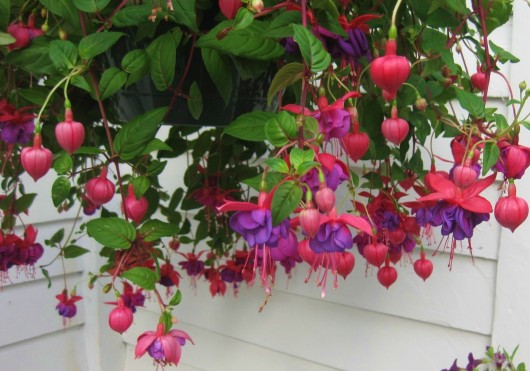 Container-Grown Plants. The roots of potted plants (like the fuchsia above) can’t forage for food and moisture like their garden-grown colleagues can. I feed mine daily, high phosphorus for the patio flowers and an acidic formula for the Boston ferns on the front porch. Give water twice daily during periods of high heat.
Container-Grown Plants. The roots of potted plants (like the fuchsia above) can’t forage for food and moisture like their garden-grown colleagues can. I feed mine daily, high phosphorus for the patio flowers and an acidic formula for the Boston ferns on the front porch. Give water twice daily during periods of high heat.
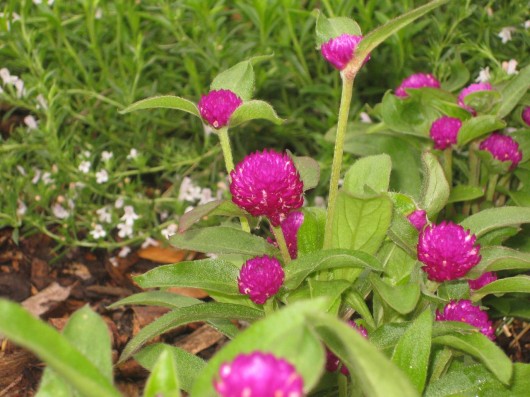 Annuals. You can count on Gomphrena (above) and others to explode with color this month. To ensure continued bloom, take care to remove flowers as they fade. Cut fresh stems of bachelor buttons, zinnias, and scented trailing petunias for splendid house-bouquets. Flowers indoors do wonders for our emotional well-being.
Annuals. You can count on Gomphrena (above) and others to explode with color this month. To ensure continued bloom, take care to remove flowers as they fade. Cut fresh stems of bachelor buttons, zinnias, and scented trailing petunias for splendid house-bouquets. Flowers indoors do wonders for our emotional well-being.
Potted Geraniums. If you want these to bloom indoors in winter, remember to pinch flower buds off during summer.
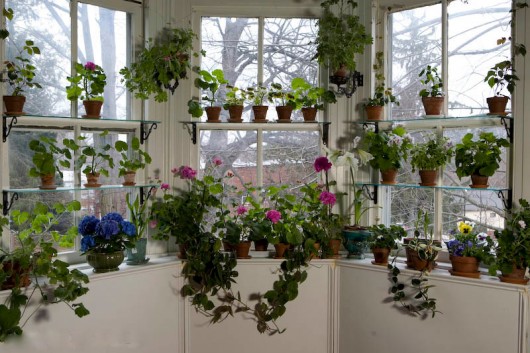 Impatiens & Others. Some cool morning in July, cut stems from your impatiens, wax begonias and petunias, and root them in pots of good soil. These, if brought indoors in September, will bloom in your window garden all winter long. More details.
Impatiens & Others. Some cool morning in July, cut stems from your impatiens, wax begonias and petunias, and root them in pots of good soil. These, if brought indoors in September, will bloom in your window garden all winter long. More details.
Roses. Deadhead regularly, cutting just above a set of five leaves. It is from this point that new flowering growth will emerge.
Japanese Beetles. Who else loathes these chewing insects that skeletonize the flowers of roses and other ornamentals? I pluck them off my plants and immediately drop them into a jar of soapy water.
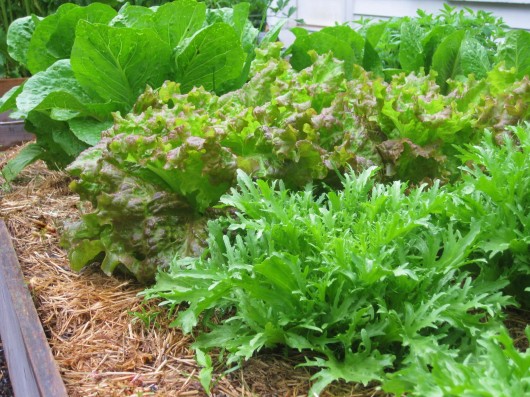 Salad Greens. After your spinach, lettuce, and other salad greens bolt, sow fresh crops in shady quarters. (And speaking of lettuce…have you tried my Lettuce & Lovage Soup yet?)
Salad Greens. After your spinach, lettuce, and other salad greens bolt, sow fresh crops in shady quarters. (And speaking of lettuce…have you tried my Lettuce & Lovage Soup yet?)
Plant Fall Crops. Certain crops can be planted now for autumn harvest. My own July sowing-schedule includes beets, beans, cucumbers, radish, and broccoli.
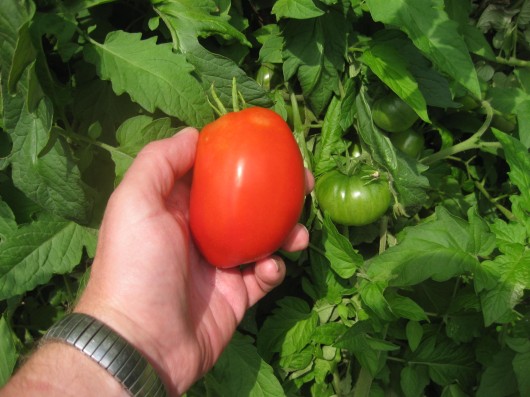 Tomatoes. You will achieve healthier plants and larger fruit if you remove suckers from vines.
Tomatoes. You will achieve healthier plants and larger fruit if you remove suckers from vines.
Watch for Blossom End Rot, or “BER.” If you notice a dark, mushy patch at the blossom end of young zucchini, tomatoes, peppers and others, the culprit is usually blossom end rot. BER is not a disease, but a physiological condition. It is caused by a calcium deficiency, induced, more often than not, by improper watering (i.e., letting the soil get too dry, and then flooding it with water). You can cure BER by providing your plants with steady moisture and a layer of mulch. Clean, crushed eggshells, if buried around plants (be careful not to injure roots) will provide extra calcium.
Herbs. Don’t wait until autumn to harvest your herbs. Snip them now, at their peak of perfection, and then freeze them. I use three simple techniques for freezing herbs. Would you like to see them?
Don’t miss anything at A Garden for the House…sign up for Kevin’s weekly newsletter.
Related Posts:
Blueberry Bars
The Powers of Flowers Indoors
My First “Open Day” and A Brief Tour

David says
Beautiful Flowers..
Shade Trees
Adele says
Wow! Your tomatoes have really grown! How's that sumac teepee working out?
Love the violet “gomp,” too. I'll have to plant that next year.
Carol says
Thanks for the “easy” July schedule. It's cool here now, but things are expected to really heat up next week. Like in the 90s every day. Ugh.
Broken Barn Industries says
I'm up at dawn every day and every day I swear I'll get out into the garden before it gets hot. Instead, I get sucked into computer/ coffee world. The only day this season I DID get out there early was when my internet was out! As for bouquets, I do a new one almost every day and try to make sure guests leave with one. Gotta work on that morning thing…
Kevin Lee Jacobs says
I know what you mean about morning internet…pour a coffee and before you know it 3 hours have passed.
Patty says
Excellent tips! I never knew about cutting roses back to an area of five leaves. I learn so much from your blog!
snowflake says
Hi Kevin… Happy Fourth…have a great day…
a quick question. Does a raised bed need more than an inch of water a week? Or do you water them like your gardens? thanks..
Kevin Lee Jacobs says
Patty – you're welcome!
snowflake – happy 4th to you, too. No, I do not give my raised beds more than one inch of water per week. But the beds are heavily mulched, some with chopped straw, others with shredded leaves. This mulch does wonders to conserve moisture.
Unless there is adequate rainfall, my once-a-week routine is this: I set an oscillating sprinkler on a bench in the center of the kitchen garden, and let it run for exactly 2 hours. From my experience, this is the time it takes to collect one inch of water.
snowflake says
thank you…
[email protected] says
Can I plant colchicums and fall blooming crocus now?
Darlene says
How timely! My baby yellow squash are soft and dark at the blossom end, and I thought it was a fungus. In truth, I haven’t been watering very evenly. Should I remove the damaged fruit?
Kevin Lee Jacobs says
Darlene – So glad that BER tip came to you at the right time. Definitely remove the damaged squash.
Ann says
Kevin, I discovered your site this summer. I love reading your “pearls” on gardening and life in general.
Do you mind sharing the brand of high phosphorus feed you apply to your annuals?
Thank you
Kevin Lee Jacobs says
Hi Ann – Over the years, I’ve tried many brands. Just now I’m happy with “Jack’s Classic Blossom Booster.” The N-P-K for this water-soluble product is 10-30-20.
Marshall says
Love the site!! Love the articles!! Learn something, every time I am here….however, I want to take issue with your 1st sentence in this month’s article under “Watering.” In there you say “If Nature doesn’t provide this moisture, your garden hose will.”
Having worked, the past two years with our local watershed partnership…I’d like to think there would be a lot of “Green Thumb Folks” out there, who would go to their “Rain Barrel” before turning on the hose. I understand, some folks have no idea what a “Rain Barrel” might be….could be a good lead-in on next month’s article.
Keep up the good work….we appreciate you!!
Beverly says
There is some debate about the safety of using rain barrel water on edible crops.
Look into that before you apply water harvested from shingled rooftops to a kitchen garden….
Kevin Lee Jacobs says
Marshall – I love the idea of rain barrels. They are ideal where a building with a clean roof is located near a garden. Alas, with the exception of my rose and herb gardens, all other gardens here are located far, far away from any structures where rain water could be collected.
Beverly – The roof near my rose garden is asphalt shingled (probably a no-no for water-collection) , while the roof near my herb patch is tin. The tin roof is ancient — and no doubt contains lead paint beneath numerous coats of non-lead paint. So here again, I think it is unsuited for the collection of water. Bummer.
wendy says
wonderful tips. I have been able to keep squash bugs at bay so naturally I would love to stop “BER”. I shall clean and crush egg shells post haste! I do need to make a more balanced watering routine. Thanks!
MaryB says
Can you just set a big plastic can in the garden to collect the rain? It wouldn’t be as good as a real water gathering system, but ……… Anyhow, I loved your picture of the butterfly on the zinnia. I have a similar picture on my site,but it is a butterfly on an aiium. You might likee!
Denise in NJ says
MaryB, yes you can. I have a 55 gal plastic drum on top of a couple of rows of cinderblock. The entire top is open with screening across and I installed a spigot at the bottom. It does a very nice job at collecting rainwater. If extreme weather like a hurricane is forecast, I fill it with my hose, just in case I need it. The only caveat: you’ve got to “rotate” the water by using it regularly so mosquitoes don’t breed in it. I’ve read conflicting reviews about whether it’s safe to use anything like mosquito dunks in water used on edibles, so I just make sure I use up the water each week so it doesn’t sit long enough for them to breed.
Mary Ann Salsman says
I read that using 2 cups water and 1 cup dry milk powder will up the calcium level of plants. Just pour at the base.
Barb L. says
Hi, Kevin. I love this site. I just finished a July chore that I’d like to share with readers. After losing my entire squash crop the last two years, I researched and found that a moth lays tiny red eggs that hatch into squash vine borers. I’ve been watching my plants carefully, and when I found some eggs this morning I started picking them off meticulously. After a few minutes of this in 90 degree heat, I grabbed my duct tape and used small strips to nab DOZENS of eggs. Many were at the soil line and I couldn’t even see them. It was quick and easy, and the tape held the eggs tight until I disposed of them. I’ll continue this routine as long as I find eggs. I’m hoping for a huge harvest come fall!
Kevin Lee Jacobs says
Barb L. – Kudos to you for inventing a quick and efficient way to remove the eggs of squash vine borers!
Pamela Tull says
Hello Kevin,
Would you decribe in detail how you built your raised kitchen garden boxes (sizes, type
of wood used, what you used within the box wood walls to plant your garden in), and how many your placed within what size garden.
Thank you.
/Pamela Tull
Kevin Lee Jacobs says
Hi Pamela – Thanks for asking. The details concerning my raised beds are here.